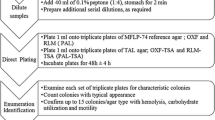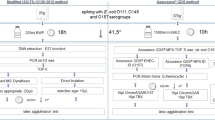Abstract
The use of right sample preparation protocols is critical when analyzing challenging matrices containing inhibitory compounds inhibiting Salmonella growth during pre-enrichment step. The use of right sample preparation protocols will not only avoid a false negative result, but it can also have a huge positive impact on laboratory operations, as it is used for every type of method (cultural, ELISA, or PCR), every day in every laboratory. Sample preparation instructions to overcome the inhibitory effects are limited and for most cases an increase in the dilution factor (i.e., an increase of the volume of pre-enrichment broth). In this study, two neutralizers were identified as suitable alternatives for Salmonella detection in spices, natural flavors, and other food items (coffee, tea). Pre-enrichment with buffered peptone water and activated charcoal is considered the preferred solution, since it is cheaper to use and applicable to a broad range of food items, including coffee, vanilla, allspice, onion, tea, and peppermint with limit of detection between 0.63 and 2.45 cfu/25g whereas other food items like cinnamon and mustard were inactivated by buffered peptone water with cocktail of neutralizers (limit of detection between 0.35 and 1.05 cfu/25g). The use of neutralizers can reduce the analytical cost for Salmonella analysis as well as reducing the amount of reagents used (ranging from 1 L up to 4.5 L per 25-g sample) which will have a positive impact on laboratory operation workload as well as ergonomics and the environment.
Similar content being viewed by others
Data Availability
The datasets generated during and/or analyzed during the current study are available from the corresponding author on reasonable request.
References
Akinpelu DA, Aiyegoro OA, Akinpelu OF, Okoh AI (2014) Stem bark extract and fraction of Persea americana (Mill.) exhibits bactericidal activities against strains of Bacillus cereus associated with food poisoning. Molecules 20(1):416–429
Beaubrun J, Flamer M-L, Addy N, Ewing L, Gopinath GR, Jarvis K, Grim CJ, Hanes D (2016) Evaluation of corn oil as an additive in the pre-enrichment step to increase recovery of Salmonella enterica from oregano. Food Microb 57:195–203
Beaubrun J, Addy N, Keltner Z, Farris S, Ewing L, Gopinath G, Hanes D (2018) Evaluation of the impact of varied carvacrol concentrations on Salmonella recovery in oregano and how corn oil can minimize the effect of carvacrol during preenrichment. J Food Prot 81(6):977–985
Brehm-Stecher B, Young C, Jaykus LA, Tortorello ML (2009) Sample preparation: the forgotten beginning. J Food Prot 72(8):1774–1789
Cortés-Rojas DF, de Souza CRF, Oliveira WP (2014) Clove (Syzygium aromaticum): a precious spice. Asian Pacific J Tropical Biomed 4(2):90–96
Dabrowski A, Podkoscielny P, Hubicki Z, Barczak M (2005) Adsorption of phenolic compounds by activated carbon—a critical review. Chemosphere 58:1049–1070
Dai R, Lim LT (2014) Release of allyl isothiocyanate from mustard seed meal powder. J Food Sci 79(1):47–53
EN 1276 (2020) Chemical disinfectants and antiseptics - quantitative suspension test for the evaluation of bactericidal activity of chemical disinfectants and antiseptics used in food, industrial, domestic and institutional areas - test method and requirements (phase 2, step 1)
Espigares E, Bueno A, Fernandez-Crehuet M, Espigares M (2003) Efficacy of some neutralizers in suspension tests determining the activity of disinfectants. J Hosp Infection 55(2):137–140
Farah A, Lima JP (2018) Major chlorogenic acids’ contents and distribution in coffees. In: Coffee: production, quality and chemistry; Royal Society of Chemistry, London, UK ISBN 978-1782620044
Friedman M, Kozukue N, Harden LA (2000) Cinnamaldehyde content in foods determined by gas chromatography-mass spectrometry. J Agr Food Chem 48(11):5702–5709
ISO 11133 (2014) Microbiology of food, animal feed and water - preparation, production, storage and performance testing of culture media
ISO 16140-2 (2016) Microbiology of the food chain - method validation - Part 2: protocol for the validation of alternative (proprietary) methods against a reference method
ISO 6579-1 (2017) Microbiology of the food chain. Horizontal method for the detection, enumeration and serotyping of Salmonella - Part 1: Detection of Salmonella spp.
ISO 6887-4 (2017) Microbiology of the food chain — preparation of test samples, initial suspension and decimal dilutions for microbiological examination — Part 4: specific rules for the preparation of miscellaneous products
ISO 11930 (2019) Cosmetics - microbiology - evaluation of the antimicrobial protection of a cosmetic product
Jernberg C, Hjertqvist M, Sundborger C, Castro E, Löfdahl M, Pääjärvi A, Sundqvist L, Löf E (2015) Outbreak of Salmonella Enteritidis phage type 13a infection in Sweden linked to imported dried-vegetable spice mixes, December 2014 to July 2015. Euro Surveill : Bull Euro Sur Les Maladies Transmissibles = Euro Commun Dis Bull 20(30)
Komes D, Horžić D, Belščak A, Kovačević GK, Baljak A (2009) Determination of caffeine content in tea and maté tea by using different methods. Czech J Food Sci 27(Spec Issue 1):S213–S216
Liu Q, Meng X, Li Y, Zhao C-N, Tang G-Y, Li H-B (2017) Antibacterial and antifungal activities of spices. Int J Mol Sci 18(6)
Ludwig IA, Mena P, Calani L, Lean MEJ, Crozier A (2014) Variations in caffeine and chlorogenic acid contents of coffees: what are we drinking? Food Funct 5(8):1718–1726
MacKinnon IH (1974) The use of inactivators in the evaluation of disinfectants. J Hygiene 73(2):189–195
Pandima DK, Arif NS, Sakthivel R, Karutha PS (2010) Eugenol (an essential oil of clove) acts as an antibacterial agent against Salmonella typhi by disrupting the cellular membrane. J Ethnopharmacol 130:107–115
Pezzoli L, Elson R, Little CL, Yip H, Fisher I, Yishai R, Anis E, Valinsky L, Biggerstaff M, Patel N, Mather H, Brown DJ, Coia JE, van Pelt W, Nielsen EM, Ethelberg S, de Pinna E, Hampton MD, Peters T, Threlfall J (2008) Packed with Salmonella—investigation of an international outbreak of Salmonella senftenberg infection linked to contamination of prepacked basil in 2007. Foodborne Path Dis 5(5):661–668
Samadi N, Shahverdi AR, Fazeli MR, Elmi F, Mehrgana H (2006) Evaluation of neutralizing efficacy and possible microbial cell roxicity of a universal neutralizer proposed by the CTPA. Iranian J Pharm Res 5(3):173–178
Shabnum S, A. W. M. G (2011) Essential oil composition of Thymus vulgaris L. and their uses. J Res Dev 11:83–94
Stewart T-MA, Lowe HI, Watson CT (2016) Quantification and characterization of Pimenta dioica (Allspice) essential oil extracted via hydrodistillation, solvent and super critical fluid extraction methodologies. Am J Essent Oils Nat Prod 4(3):27–30
Sutton SVW, Proud DW, Rachui S, Brannan DK (2002) Validation of microbial recovery from disinfectants. PDA J Pharm Sci Tech 56(5):255–266
USDA (2011) Database for the flavonoid content of selected foods. Release 3
Van Doren JM, Neil KP, Parish M, Gieraltowski L, Gould LH, Gombas KL (2013) Foodborne illness outbreaks from microbial contaminants in spices, 1973-2010. Food Microb 36(2):456–464
Vij V, Ailes E, Wolyniak C, Angulo FJ, Klontz KC (2006) Recalls of spices due to bacterial contamination monitored by the U.S. Food and Drug Administration: the predominance of Salmonellae. J Food Prot 69(1):233–237
Wilrich and Wilrich (2009) Estimation of the POD function and the LOD of a qualitative microbiological measurement method. J AOAC Int 92(6)
Wilson CR, Andrews WH (1976) Sulfite compounds as neutralizers of spice toxicity for Salmonella. J Milk Food Tech 39(7):464–466
Wu VCH (2008) A review of microbial injury and recovery methods in food. Food Microb 25(6):735–744
Zhang G, Ali L, Gill V, Tatavarthy A, Deng X, Hu L, Brown E, Hammack T (2017) Development and validation of a cultural method for the detection and isolation of Salmonella in cloves. J Food Prot 80(3):376–382
Acknowledgements
The authors would like to thank Veronika Knapkova, Daniela Correia, Olivier Guillaume-Gentil, and Menaka Subrahmanyam from Nestlé PTC Orbe (Switzerland) for the organization of the preliminary trails with coffee, samples provided, and technical support; Carol Sivey from Micro Technical Services from Nestlé NQAC Dublin (USA) for the preliminary trials with spices and neutralizers; James Clulow from Special T-Product Integration (Orbe) for providing tea samples; Rolf Ossmer and Barbara Gerten from MERCK for the technical support, identification of neutralizers, and the culture media and reagents provided; and Miguel Espigares García and Elena Espigares Rodriguez from Granada University (Spain) for the combination of chemical substances suggested for the neutralizers.
Author information
Authors and Affiliations
Contributions
David Tomas Fornes and Adrianne Klijn, drafted the manuscript, defined the objectives, designed the work and performed the interpretation of the data obtained.
Amparo de Benito and Begoña Ruiz performed the analysis and generated the data included in the study.
All authors revised it critically and approved the version to be published.
Corresponding author
Ethics declarations
Ethics Approval
This research does not involve any human or animal participant, their data or biological material.
Conflict of Interest
David Tomás Fornés declares that he has no conflict of interest. Amparo De Benito declares that he has no conflict of interest. Begoña Ruiz declares that he has no conflict of interest. Adrianne Klijn declares that he has no conflict of interest.
Additional information
Publisher’s Note
Springer Nature remains neutral with regard to jurisdictional claims in published maps and institutional affiliations.
Rights and permissions
Springer Nature or its licensor (e.g. a society or other partner) holds exclusive rights to this article under a publishing agreement with the author(s) or other rightsholder(s); author self-archiving of the accepted manuscript version of this article is solely governed by the terms of such publishing agreement and applicable law.
About this article
Cite this article
Tomás Fornés, D., De Benito, A., Ruiz, B. et al. Use of Neutralizers to Improve Salmonella spp. Detection in Inhibitory Food Matrices. Food Anal. Methods 16, 1680–1689 (2023). https://doi.org/10.1007/s12161-023-02536-y
Received:
Accepted:
Published:
Issue Date:
DOI: https://doi.org/10.1007/s12161-023-02536-y




